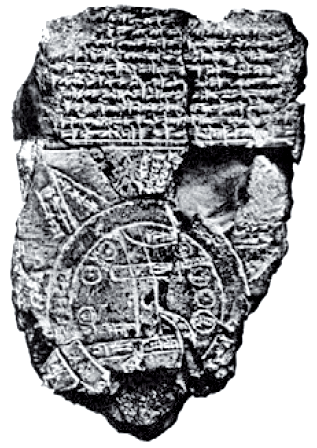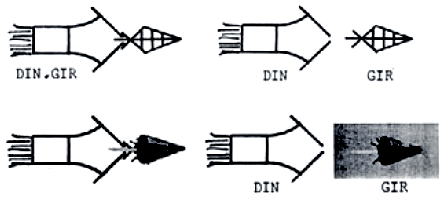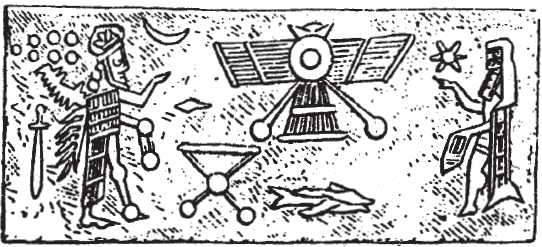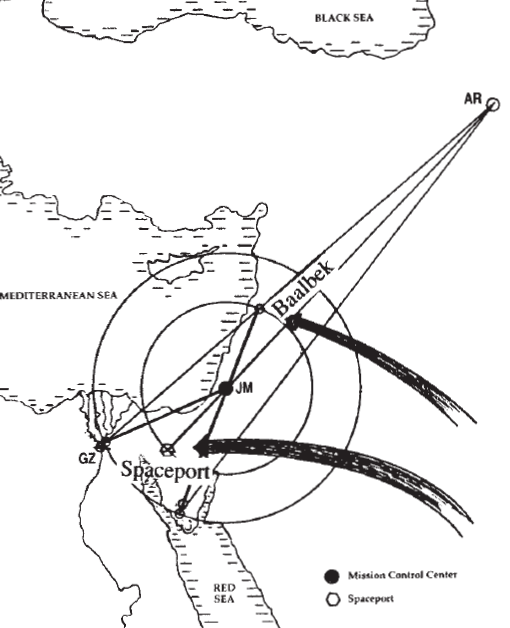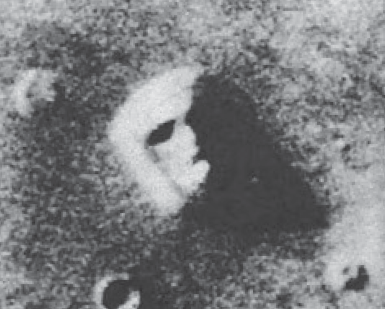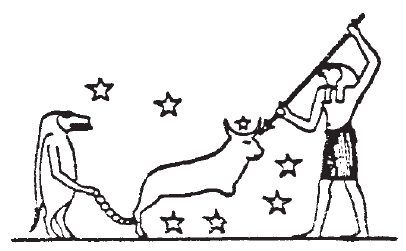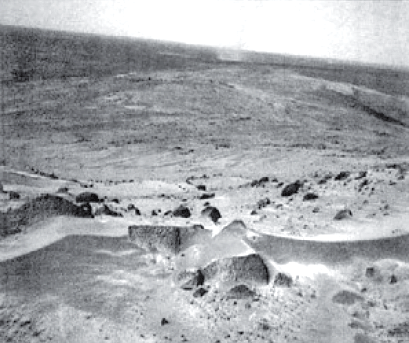|
“AND IT CAME TO PASS”
This is how the Bible recorded the most audacious attempt— by Marduk!—to assert his supremacy by establishing his own city in the heart of Enlilite domains and, moreover, to build there his own space facility with its own launch tower.
The place is named in the Bible
Babel, “Babylon” in English.
It recognizes that it was there that Man’s first urban civilization began—the building of cities. It correctly notes (and explains) that in that land, where the soil consisted of layers of dried mud and there is no native rock, the people used mud bricks for building and by hardening the bricks in kilns could use them instead of stone.
It also refers to the use of
bitumen as mortar in construction—an astounding bit of information,
since bitumen, a natural petroleum product, seeped up from the
ground in southern Mesopotamia but was totally absent in the Land of
Israel.
As in the tales of the creation of Adam and of the Deluge, they melded the various Sumerian deities into the plural Elohim or into an all-encompassing and supreme Yahweh, but they left in the tale the fact that it took a group of deities to say,
Sumerian and later Babylonian records attest to the veracity of the biblical tale and contain many more details, linking the incident to the overall strained relationships between the gods that caused the outbreak of two “Pyramid Wars” after the Deluge.
The “Peace on Earth” arrangements, circa 8650 b.c.e., left the erstwhile Edin in Enlilite hands. That conformed to the decisions of Anu, Enlil, and even Enki—but was never acquiesced to by Marduk/Ra.
And so it was that when Cities of Men began to be allocated in the former Edin to the gods, Marduk raised the issue,
Although Sumer was the heartland of the Enlilite territories and its cities were Enlilite “cult centers,” there was one exception: in the south of Sumer, at the edge of the marshlands, there was Eridu; it was rebuilt after the Deluge at the exact same site where Ea/Enki’s first settlement on Earth had been.
It was Anu’s insistence, when
the Earth was divided among the rival Anunnaki clans, that Enki
forever retain Eridu as his own. Circa 3460 b.c.e. Marduk decided
that he could extend his father’s privilege to also having his own
foothold in the Enlilite heartland.
A later map of Babylon, drawn on a clay tablet (Fig.
10) represents it as a “Navel of the Earth”—akin to Nippur’s
original function-title. The name Marduk gave the place, Bab-Ili in Akkadian, meant “Gateway of the gods”—a place from which the gods
could ascend and descend, where the appropriate main facility was to
be a “tower whose head shall reach the heavens”—a launch tower!
Though fragmented, the Mesopotamian texts (first translated by George Smith in 1876) make it clear that Marduk’s act infuriated Enlil, who “in his anger a command poured out” for a nighttime attack to destroy the tower.
Figure 10
Egyptian records report that a chaotic period that lasted 350 years
preceded the start of Pharaonic kingship in Egypt, circa 3l10 b.c.e.
It is this time frame that leads us to date the Tower of Babel
incident to circa 3460 b.c.e., for the end of that chaotic period
marked the return of Marduk/Ra to Egypt, the expulsion of Thoth, and
the start of the worship of Ra.
Since, in the end, Marduk did attain his aims in
Babylon, the interesting question is: Why did he fail in 3460
b.c.e.? The equally interesting answer is: It was a matter of
timing.
The list of
“honorees” changed as time went by, as did the composition of the
membership of the supreme Pantheon of Twelve. The month associations
also changed locally, not only in various lands but sometimes to
recognize the city god. We know, for example, that the planet we
call Venus was initially associated with Ninmah and later on with
Inanna/Ishtar.
And then there were the nicknames comparing the prowess, strength, or characteristics of a god with an animal held in awe; Enlil’s, as text after text reiterated, was the Bull.
Figure 11 It was depicted on cylinder seals, on tablets dealing with astronomy, and in art. Some of the most beautiful art objects discovered in the Royal Tombs of Ur were bull heads sculpted in bronze, silver, and gold, adorned with semiprecious stones. Without doubt, the constellation of the Bull—Taurus— honored and symbolized Enlil.
Its
name, GUD.ANNA, meant “The Bull of Heaven,” and texts dealing with
an actual “Bull of Heaven” linked Enlil and his constellation to one
of the most unique places on Earth.
It was, Sumerian texts attested, the only
structure that had survived the Deluge, and could thus serve right
after the Deluge as a base of operations for the Anunnaki; from it
they revived the ravished lands with crops and domesticated animals.
The place, called the “Landing Place” in the Epic of Gilgamesh, was
that king’s destination in his search for immortality; we learn from
the epic tale that it was there, in the sacred cedar forest, that Enlil kept the GUD.ANNA—the “Bull of Heaven,” the symbol of Enlil’s
Age of the Bull.
That made Gilgamesh not a mere demi-god, but one who was “two-thirds divine.”
Figure 12 As he got older and began to contemplate matters of life and death, it occurred to him that being two-thirds divine ought to make a difference; why should he “peer over the wall” like an ordinary mortal? he asked his mother.
She agreed with him, but explained to
him that the apparent immortality of the gods was in reality
longevity due to the long orbital period of their planet. To attain
such longevity he had to join the gods on Nibiru; and to do that, he
had to go to the place where the rocket ships ascend and descend.
There were, in fact, not one but two journeys (Fig. 13):
Figure 13 In the first journey circa 2860 b.c.e.—to the Cedar Forest in Lebanon—the duo were assisted by the god Shamash, the godfather of Gilgamesh, and the going was relatively quick and easy.
After they reached the forest they witnessed during the night the launching of a rocket ship.
This is how Gilgamesh described it:
Figure 14
Awed but undeterred, the next day Gilgamesh and Enkidu discovered the secret entrance that had been used by the Anunnaki, but as soon as they entered it, they were attacked by a robot-like guardian who was armed with death beams and a revolving fire.
They managed to destroy the monster, and relaxed by a brook thinking that their way in was clear.
But when they ventured deeper into the Cedar Forest, a
new challenger appeared: the Bull of Heaven.
The text becomes legible where the
boastful Gilgamesh, who cut off the bull’s thigh, “called
the craftsmen, the armorers, the artisans” of Uruk to admire the
bull’s horns. The text suggest that they were artificially
made—“each is cast from thirty minas of lapis, the coating on each
is two fingers thick.”
What we do know for certain is that upon its slaying,
The matter was so serious that Anu, Enlil, Enki, and
Shamash formed a divine council to judge the comrades (only Enkidu
ended up being punished) and to consider the slaying’s consequences.
We know from Egyptian sources, including pictorial depictions in astronomical papyri (Fig. 15), that the slaying’s symbolism was not lost on Marduk: it was taken to mean that in the heavens, too, the Age of Enlil had been cut short.
Figure 15
Marduk’s attempt to establish an alternative space facility was not
taken lightly by the Enlilites; the evidence suggests that Enlil and
Ninurta were preoccupied with establishing their own alternative
space facility on the other side of the Earth, in the Americas, near
the post-Diluvial sources of gold.
One day, as she was
roaming the skies in her Sky Chamber—it happened circa 2360 b.c.e.—she landed in a garden next to a sleeping man who had caught
her fancy. She liked the sex, she liked the man. He was a Westerner,
speaking a Semitic language. As he wrote later in his memoirs, he
knew not who his father was, but knew that his mother was an Entu, a
god’s priestess, who put him in a reed basket that was carried by
the river’s flowing waters to a garden tended by Akki the Irrigator,
who raised him as a son.
Not stemming from the previous recognized royal Sumerian lineages, he could not ascend the throne in any one of the olden capitals, and a brand-new city was established to serve as his capital. It was called Aggade— “Union City.”
Our textbooks call this king Sargon of Akkad and his Semitic
language Akkadian. His kingdom, which added northern and
northwestern provinces to ancient Sumer, was called Sumer & Akkad.
Sargon’s military expeditions were recorded and glorified in his own royal annals; his achievements were summarized in the Sargon Chronicle thus:
The boast implies that the sacred space-related site, the Landing Place deep in the “country of the west,” was captured and held in behalf of Inanna/Ishtar—but not without opposition.
Even texts written in glorification of Sargon state that “in his old age all the provinces revolted against him.”
Counter annals, recording the events as viewed from Marduk’s side, reveal that Marduk led a punishing counteroffensive:
Sargon’s territorial reach, it needs to be noted, included only one of the four post-Diluvial space-related sites—only the Landing Place in the Cedar Forest (see Fig. 3).
Sargon was briefly succeeded on the throne of Sumer & Akkad by two sons, but his true successor in spirit and deed was a grandson named Naram-Sin. The name meant “Sin’s favorite,” but the annals and inscriptions concerning his reign and military campaigns show that he was in fact Ishtar’s favorite.
Texts and depictions record that Ishtar encouraged the king to seek grandeur and greatness by ceaseless conquest and destruction of her enemies, actively assisting him on the battlefields. Depictions of her, which used to show her as an enticing goddess of love, now showed her as a goddess of war, bristling with weapons (Fig. 16).
Figure 16
It was warfare not without a plan—a plan to counter Marduk’s ambitions by capturing all the space-related sites in behalf of Inanna/Ishtar. The lists of cities captured or subdued by Naram-Sin indicate that he not only reached the Mediterranean Sea—assuring control of the Landing Place—but also turned southward to invade Egypt.
Such an incursion into the Enki’ite domains was unprecedented, and it could take place, a careful reading of the records reveals, because Inanna/Ishtar had formed an unholy alliance with Nergal, Marduk’s brother who espoused Inanna’s sister. The thrust into Egypt also required entering and crossing the neutral Sacred Region in the Sinai Peninsula, where the spaceport was located—another breach of the olden Peace Treaty.
Boastful, Naram-Sin gave himself the title “King of the four regions”...
And so the “word of Ekur”—the decision of Enlil from his temple in Nippur—was to put an end to it:
Naram-Sin’s end came circa 2260
b.c.e.; texts from that time report that troops from the territory
in the east, called Gutium, loyal to Ninurta, were the instrument of
divine wrath; Aggade was never rebuilt, never resettled; that royal
city, indeed, has never been found.
It was the first time that
being divinely anointed—which is what “Messiah” literally
means—appears in ancient inscriptions.
Looking back, recalling similar biblical prophecies, it is clear that on the eve of the twenty-first century b.c.e., gods and men expected a coming Apocalyptic Time.
|
